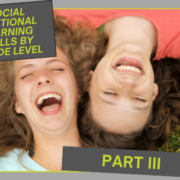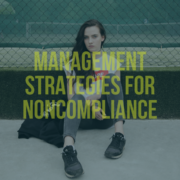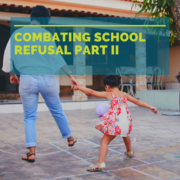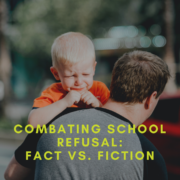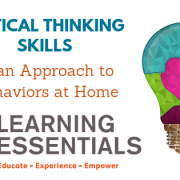Social Emotional Learning Skills by Grade Level: Part III
By the time students reach middle school, the basic foundational skills for social-emotional intelligence are in place. Preteens and teenagers are now ready to face greater obstacles and challenges, especially with regard to peer relationships, stress, and self-motivation. To meet new benchmarks, students in middle and high school must learn to deal with more significant academic struggles, greater peer influences, ever-changing teenage social dynamics, and their own personal growth and development at the same time.
| SEL Middle School Benchmarks | SEL High School Benchmarks |
| Students should begin to recognize circumstances and situations that cause extra or unnecessary stress; they should begin to adopt strategies to help with motivation, stress management, and task completion. | High schoolers should begin to understand how expressing one’s own emotions/feelings can have both positive and negative impacts on others. For example, as young adults, they need to know that positivity begets positivity, especially when emotions are running high. |
| Middle schoolers should begin to recognize the benefits of strong self-advocacy skills and how to best utilize the resources and supports that are at their disposal. For instance, if schools offer after–school homework help, students who know that they struggle to complete assignments on their own should take initiative by signing up for the club/program and making a point to attend. | High schoolers will have developed the ability to multitask by this point. However, more than multitasking, HS students should be able to shift back and forth between various tasks and under wavering conditions or circumstances. For instance, if completing a chapter review for English, a high schooler may need to answer a phone call or walk the dog to then return to the chapter questions later. Perhaps they need to maintain focus on several different homework assignments while working from a bustling coffee shop. |
| Since learning to set goals in elementary school, middle schoolers should now be equipped to assess the validity of their goals so that they may make more informed, realistic, and specific goals moving forward. They should also be able to determine why they were able to reach success or not, i.e., What helped them to reach their goal? If they didn’t reach it, then why not? What prohibited them from finding success? | Students in high school should be able to capitalize on their strengths and think creatively when facing a challenge. This ability connects with problem-solving skills and ingenuity. We can’t all be great at everything, but in what way can we use our personal/individual strengths to make challenging tasks easier? This is key for college and career readiness. |
| By middle school, students should not only be able to recognize other people’s emotions, feelings, or perspectives, but they should be able to surmise why they feel or think that way. In this sense, they’re activating the ability to take another’s perspective that they learned in elementary school, then further expanding on that by making inferences. | High schoolers should be thinking about setting goals for the future after graduation. College is not the “end all be all.” But if college isn’t their plan, then what is? Young adults need to recognize how important it is to find a path, take steps to follow that path, and evaluate their progress, preferences, and goals as they go. If they want to take a gap year, what do they hope to accomplish during that year? If they are going to study abroad, how will they decide on a program and pay for it? What skill set do they plan to use for supplementary income while in or out of college? |
| Preteens not only recognize cultural differences, but they should begin to acknowledge how certain cultural differences can result in some peers being ostracized or bullied. They should then be able to begin to find ways to combat or address the bullying and/or to make others feel included and recognized. | High schoolers should be capable of showing respect for those with opposing or differing viewpoints, even if the opposing side is argumentative, dismissive, rude, etc. It is important to maintain a level of self-control even when others are not. Just because someone has a different opinion doesn’t mean they are wrong or right in their convictions. |
| Middle schoolers should be well-aware of group dynamics and what it takes to ensure the success of the group. This includes assigning roles, taking responsibility, sharing the workload, cooperating with others, etc. | As young adults soon to be out on their own in the adult world, it is critical that high schoolers recognize how we must all be concerned about the well-being of all people; we may all be different races, but we’re all part of the human race. Therefore, we can positively contribute to our communities by advocating for human rights. |
| Students in the middle school grades should be aware of negative peer pressure, what it looks like, sounds like, and feels like. They should also be able to come up with ways to combat negative peer pressure in non– confrontational ways and under various circumstances. | High schoolers should be able to assess their ability to actively listen and explain how active listening helps with conflict resolution. They should also be able to demonstrate leadership abilities within group contexts without dominating or overtaking the goal of the group. |
| Preteens should be considering their decision-making in terms of others. Before making an important decision, they should consider not only how they will benefit from their choice, but how it could impact others as well. | Young adults should be prepared to demonstrate knowledge of social norms and appropriate behaviors between and among various cultural groups. They should recognize certain expectations and norms when interacting with authority figures, children, elders, etc. |
